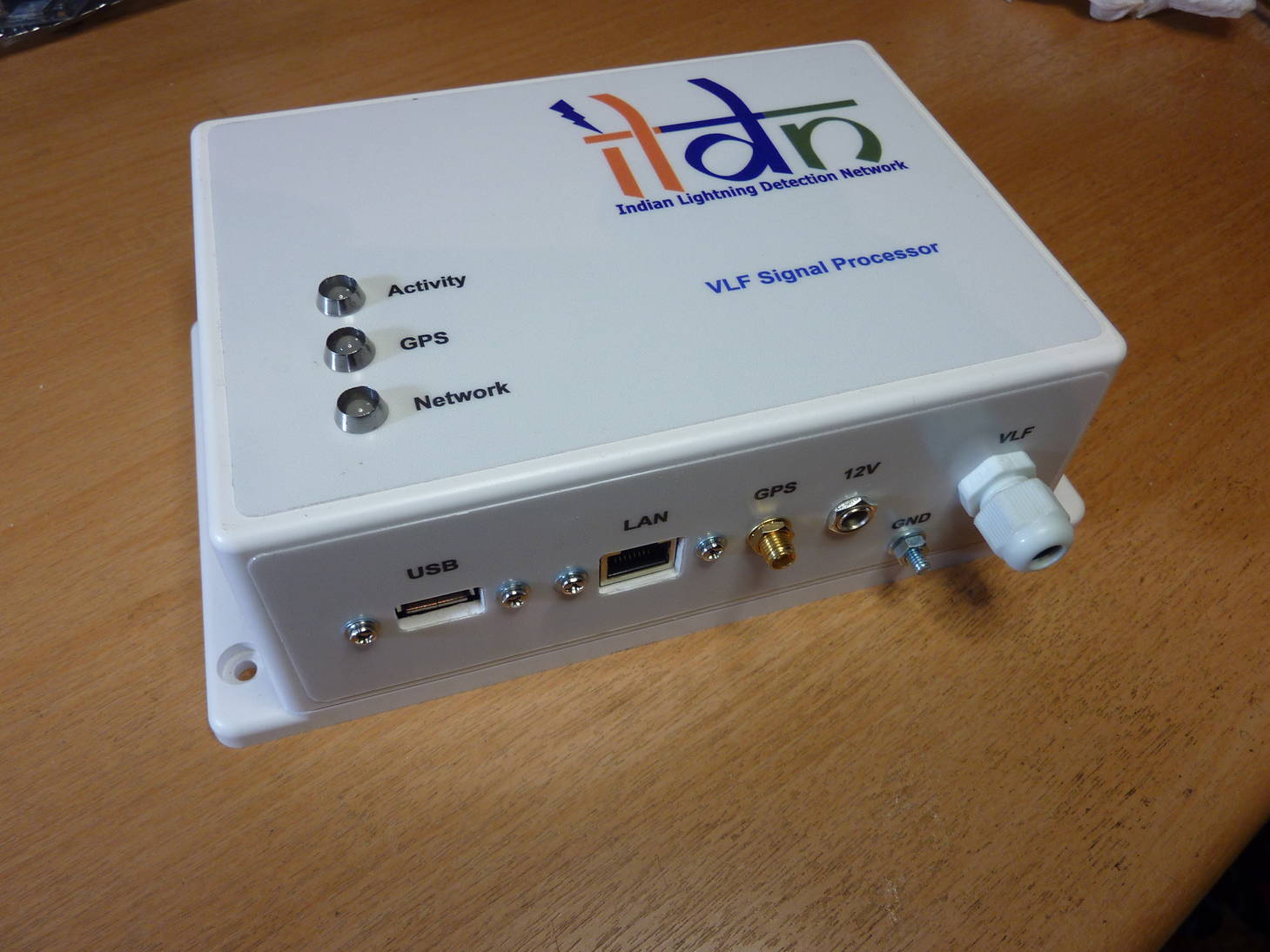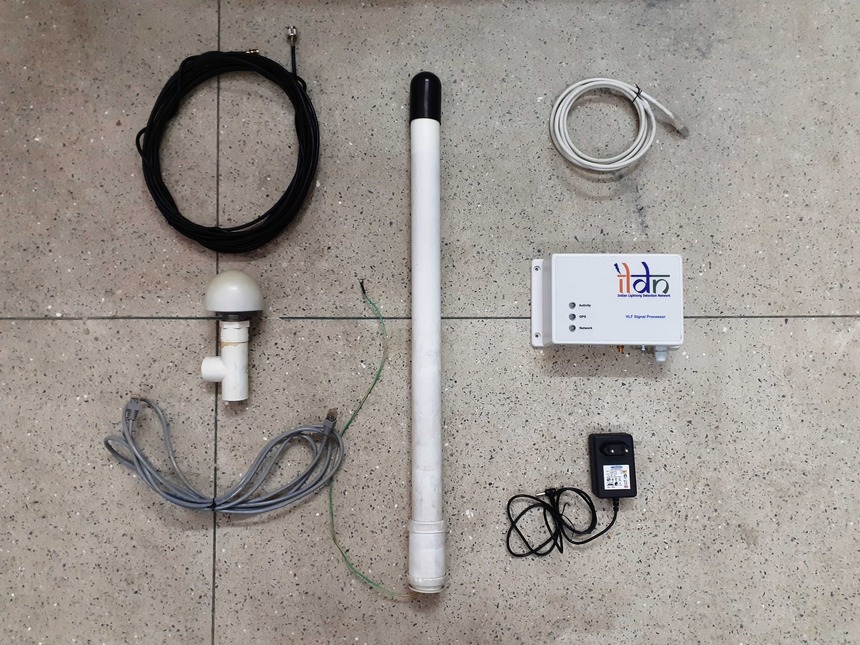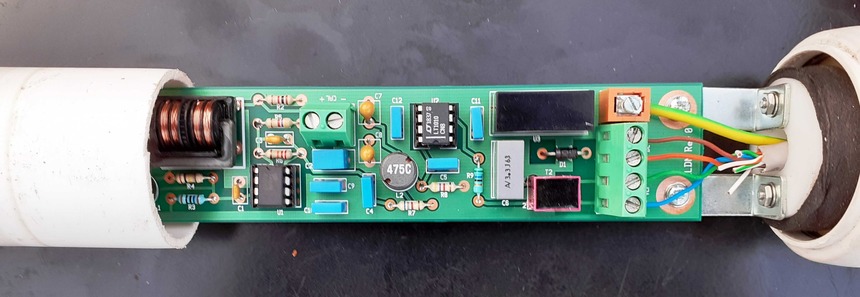

Indian Lightning Detection Network (ILDN) is the first indigenously developed experimental lightning detection system in India with a goal of academic purpose and research collaboration among interested people. The network was conceptualized in 2018 and operational from May 2022. Quality-controlled data is available starting July 2022.
Designed and managed by the Centre for Lightning and Thunderstorm Studies (CeLTS) at Tripura University, a network of Very Low Frequency (VLF) general purpose receivers and signal processors are deployed and operated across India with the help of collaborating institutions.
The primary function of the network is to detect, locate, and measure lightning strokes on the Indian subcontinent, to identify storms and track their movements, and to compile statistics on lightning distribution and trends. The network runs a number of other monitors and detectors of various phenomena occuring in the Earth's ionosphere and magnetosphere, giving a very low frequency view of the complex interplay of magnetic fields, electric currents and plasma in the regions of tenuous atmosphere that separate Earth from space - regions which interact with our regular weather through mechanisms involving lightning activity.
ILDN makes full use of high quality open source free software and of voluntary efforts by contributors and contributing institutions. In return, all data collected by ILDN is made available free of cost for non-commercial purposes. For more information, see our Data access page.
Voluntary contributions of any kind are most welcome.
Technical support from Paul Nicholson ildn[at]abelian.org;
Open source software: Linux, GNU, PostgreSQL, Apache, Leaflet, vlfrx-tools;




ILDN's VLF E-field receivers are general purpose, broad band, wide dynamic range, and very linear. Equivalent system noise density is below 100nV/m/root(Hz) from 2kHz to 48kHz and down to 20nV/m/root(Hz) for most of that range.
The receiver is in two parts - an Active Antenna supported by a Base Unit. Floating DC power uplink and balanced signal downlink are each galvanically isolated at both ends of their connecting cat5 twisted pairs. The result is excellent isolation of the antenna's local ground reference.
Received signals are GPS timestamped, cleaned with an adaptive notch filter to remove most powerline interference, and then equalised to compensate for end-to-end (E-field to data file) system response, delivering a flat phase and amplitude response and zero group delay from 400Hz to 48kHz and scaled to a unit amplitude of 300mV/m field strength.
The embedded operating system (Linux) is set up to provide a platform for ad hoc data collection for research projects, potentially supporting many fields - climate, meteorology, geophysics, ionosphere and magnetosphere studies, and the broad field of space weather. Precision measurements of the VLF E-field can provide useful observational support in all of these areas.
Our main server, facing the Internet as ildn.in, is located in Mumbai and has an excellent network service. The receivers send their data in frequent small batches to ildn.in where it is promptly processed to support near real time services.
Sferic matching and stroke location is carried out in short batches by the vtspot program from vlfrx-tools which is very capabable of sorting out an aggregate rate of several hundred sferics per second.
Sferic measurements and computed results all go into a PostgreSQL database. This is a high performance, very reliable, standards compliant SQL database with the reputation of having one of the best query engines. We make full use of its PostGIS extension for geographical queries.
A backup server located at Tripura University receives a copy of all receiver data from ildn.in and performs in parallel the same data processing. This server is also used for software testing and for those more resource demanding computations that run in background.
Web service is provided from ildn.in with the usual combination of Apache and PHP.
A strong feature of ILDN's data processing is its ability to handle late arriving data, quite essential when receivers may sometimes be on tenuous and intermittent network connections. The receivers will buffer up to 2 months of data if necessary, to forward the backlog to ILDN as soon as they can reach the Internet again.
Late arriving data at ILDN triggers recomputation to fold the incoming data into existing and new solutions, with the triggers flowing down to recompute all dependent data. This is why all of our data products are version numbered. This feature is also exploited to recompute historical results as we make improvements to the processing software.